
Marsileaceae is a small family of heterosporous aquatic and semi-aquatic ferns, though at first sight they do not physically resemble other ferns. The group is commonly known as the "pepperwort family" or as the "water-clover family" because the leaves of the genus Marsilea superficially resemble the leaves of a four-leaf clover. In all, the family contains 3 genera and 50 to 80 species with most of those belonging to Marsilea.
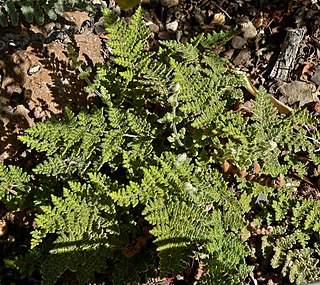
Myriopteris gracilis, formerly known as Cheilanthes feei, is a species of lip fern known by the common name slender lip fern.

Asplenium vespertinum is a species of fern known by the common name western spleenwort. It is native to southern California and Baja California, where it grows in moist, shady, rocky places, such as the shadows beneath cliff overhangs.
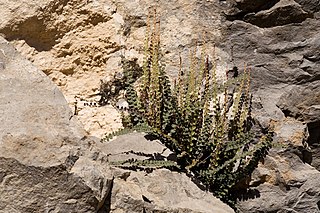
Astrolepis cochisensis is a species of fern known by the common name Cochise scaly cloak fern. It is native to the southwestern United States and northern Mexico, where it occupies mainly desert habitat, often on calcareous soils.

Myriopteris intertexta, formerly Cheilanthes intertexta, is a species of lip fern known by the common name coastal lip fern.

Cystopteris fragilis is a species of fern known by the common names brittle bladder-fern and common fragile fern. It can be found worldwide, generally in shady, moist areas. The leaves are up to 30 or 40 centimeters long and are borne on fleshy petioles with few or no long hairs. Each leaf is divided into many pairs of leaflets, each of which is subdivided into lobed segments. The underside of the leaf has many rounded sori containing the sporangia.

Pellaea brachyptera is a species of fern known by the common name Sierra cliffbrake. It is native to the coastal and inland mountains of northern California and Oregon, and a disjunct population was discovered in Chelan County, Washington, in 1986.
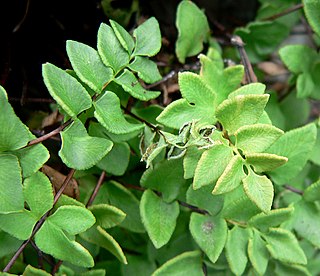
Pellaea breweri is a species of fern known by the common name Brewer's cliffbrake. It is native to much of the Western United States. It grows in rocky habitat such as cliffs and mountain slopes.
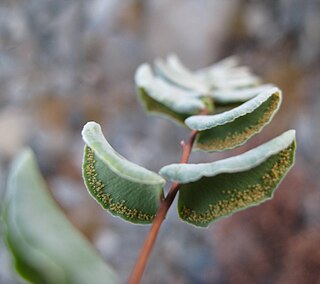
Pellaea bridgesii is a species of fern known by the common name Bridges' cliffbrake. It is native to an area of the western United States from northern California to Idaho, where it grows in rocky granitic cliffs and slopes.
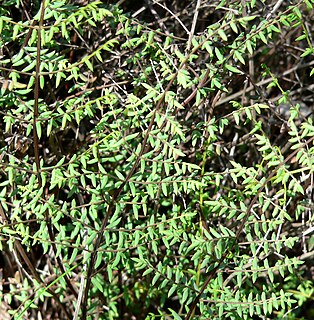
Pellaea mucronata is a species of fern known by the common name bird's foot cliffbrake.

Pellaea truncata is a species of fern known by the common name spiny cliffbrake. It is native to the southwestern United States and northern Mexico, where it grows in rocky areas, such as cliffs and slopes.
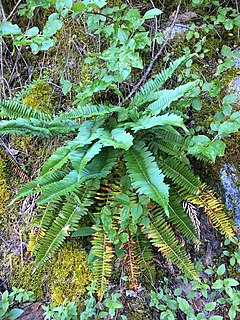
Polystichum imbricans is a species of fern known by the common names narrowleaf swordfern and imbricate sword fern. It is native to western North America from British Columbia to southern California, where it grows in rocky habitat in coastal and inland mountain ranges and foothills. This fern produces several erect linear or lance-shaped leaves up to 80 centimeters long. Each leaf is made up of many narrow, overlapping, sometimes twisting leaflets each 2 to 4 centimeters long. The leaflets have toothed edges. This fern readily forms hybrids, some of which are fertile and are considered separate species, such as Polystichum californicum, its hybrid with P. dudleyi.

Polystichum lemmonii is a species of fern known by the common names Lemmon's holly fern and Shasta fern. It is native to western North America from the Sierra Nevada of California north to Washington. It is also known from British Columbia, where there is a single occurrence in the mountains above the Okanagan Valley.

Polystichum scopulinum is a species of fern known by the common names mountain hollyfern and rock sword fern. It is native to much of western North America, and it is known from disjunct occurrences in eastern Canada, as well. It grows in rocky habitat, often in full sun. It is widespread but mostly found in small populations, and is noted to be most abundant on serpentine soils. This fern produces several erect, narrowly lance-shaped leaves up to 50 centimeters in length. The leaves narrow near the bases. Each leaf is divided into many lance-shaped or oblong leaflets up to 3 centimeters long. The toothed leaflets are sometimes twisted on their axes and overlapping.
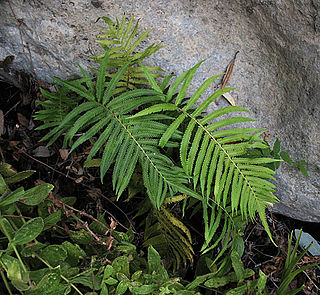
Christella puberula, synonym Thelypteris puberula, is a species of fern known by the common name showy maiden fern. The variety Ch. puberula var. sonorensis is known by the common name Sonoran maiden fern.

Woodsia plummerae is a species of fern known by the common name Plummer's cliff fern. It is native to the southwestern United States and northern Mexico, where it grows in rocky habitat in deserts and other areas. It has leaves up to 25 centimeters long with flexible reddish or purplish rachises covered in glandular hairs. The blade is made up of several pairs of leaflets which are subdivided into multilobed or toothed small segments.

Diplazium molokaiense is a rare species of fern known by the common name Molokai twinsorus fern. It is endemic to Hawaii, where it is one of the rarest ferns. It has historically been found on the islands of Kauai, Oahu, Lanai, Molokai, and Maui, but it is thought to have been extirpated from four of them and today can be found only on Maui where fewer than 70 individual plants remain. The fern was federally listed as an endangered species of the United States in 1994.

Cystopteris montana, previously classified as Athyrium montanum, is a species of fern known by the common name mountain bladderfern. It occurs throughout the high latitudes of the Northern Hemisphere, in Eurasia, Greenland, and Alaska, and throughout Canada. It is also present in the higher elevations in Colorado farther south.

Nephrolepis cordifolia, is a fern native to the global tropics, including northeastern Australia and Asia. It has many common names including fishbone fern, tuberous sword fern, tuber ladder fern, erect sword fern, narrow sword fern and ladder fern, and herringbone fern. It is similar to the related fern Nephrolepis exaltata.
Anemia tabascana is a fern endemic to the state of Tabasco, Mexico. It grows on road banks on a single hill in Huimanguillo. Like other members of the genus, its leaves are pinnately divided into a single set of leaflets; in fertile leaves, the lowest pair of leaflets projects at right angles to the rest of the leaf and bears spores. The freely forking veins, which do not rejoin one another after forking, and sparse, rather than abundant, hairs on the leaf axes, distinguish it from similar species in the genus.


















